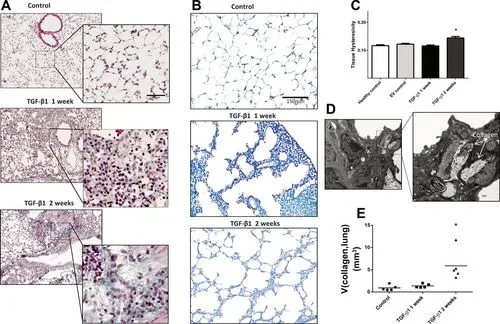Lopez-Rodriguez, E., Boden, C., Echaide, M., Perez-Gil, J., Kolb, M., Gauldie, J., Maus, U.A., Ochs, M., Knudsen, L.: Am J Physiol-Lung C. 2016;310(11):L1260-71.
To access the full article, click here:

Transforming growth factor-β1 (TGF-β1) is involved in regulation of cellular proliferation, differentiation, and fibrogenesis, inducing myofibroblast migration and increasing extracellular matrix synthesis. Here, TGF-β1 effects on pulmonary structure and function were analyzed. Adenovirus-mediated gene transfer of TGF-β1 in mice lungs was performed and evaluated by design-based stereology, invasive pulmonary function testing, and detailed analyses of the surfactant system 1 and 2 wk after gene transfer. After 1 wk decreased static compliance was linked with a dramatic alveolar derecruitment without edema formation or increase in the volume of septal wall tissue or collagen fibrils. Abnormally high surface tension correlated with downregulation of surfactant proteins B and C. TTF-1 expression was reduced, and, using PLA (proximity ligand assay) technology, we found Smad3 and TTF-1 forming complexes in vivo, which are normally translocated into the nucleus of the alveolar epithelial type II cells (AE2C) but in the presence of TGF-β1 remain in the cytoplasm. AE2C show altered morphology, resulting in loss of total apical surface area per lung and polarity. These changes of AE2C were progressive 2 wk after gene transfer and correlated with lung compliance. Although static lung compliance remained low, the volume of septal wall tissue and collagen fibrils increased 2 wk after gene transfer. In this animal model, the primary effect of TGF-β1 signaling in the lung is downregulation of surfactant proteins, high surface tension, alveolar derecruitment, and mechanical stress, which precede fibrotic tissue remodeling and progressive loss of AE2C polarity. Initial TTF-1 dysfunction is potentially linked to downregulation of surfactant proteins.




